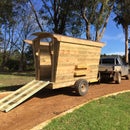Introduction: Star Dome - a Fast and Easy Geodesic Dome
With a geometry that creates a pattern of stars and pentagons, a minimal number of members and simple joint construction, the Stardome represents a fast, elegant and simple approach to geodesic dome construction. This Instructable provides an overview of building a large backyard sized dome that is 8m (25') in diameter and 4m (12½') high. The Stardome is fast to build, taking only 2½hrs from start to finish for an 8m diameter PVC dome.
UPDATE June 2018: Thanks to HannahP24 and Plasterbug for sending some great photos of their dome builds. Hannah made a small dome from bamboo strips and Plasterbug made a large PVC conduit dome. I've included plasterbug's base joint detail in the instructable.
Introduction
As a young engineering student I was naturally drawn to geodesic domes as a structural system with their promise of minimal cost and weight for maximum strength. In the early 90's I discovered the work Buckminster Fuller and eagerly read of his pioneering work on dome design and construction. Over the years I bought and built models Fuller domes from science shops and have built a newspaper tube dome with my kids While I have always been interested to build a large dome structure, the prospect of cutting and joining a large number members and joints had held me back, so I was once again enthused about building a large dome when I came across the Japanese Kyushu Fieldwork Society Stardome layout.
A Stardome is built from 15 arc shaped members wrapped around a sphere, joined where they cross and the Kyushu Stardome design creates a series of pentagons and 5 pointed stars around the periphery of the sphere. The members in a Stardome continue through the joints contributing to the Stardome's strength and stability. The Fuller Dome with its triangulated struts around the surface of the sphere has a lot more members and a far more complex joint arrangement (165 members and 61 joints for a 3V 5/8 dome).
A Stardome does require a flexible member, one that can be bent around the geodesic of the sphere. (On a sphere a geodesic is a great circle arc) compared to a Fuller Dome where the members are cut to size so a straight, rigid member can be used. A member that is slender, creating a thin shell around the sphere is also important for a Stardome. With up to 4 members overlapping at some joints, a thick member would result in the joints becoming to thick and distort the shape of the dome.
Materials
The domes built by the Kyushu Fieldwork Society are constructed from bamboo, typically split into 4 slats. Their model domes are made using paper strips. This is an ideal approach as the strips are very thin and flexible, easily bent around the sphere. The materials are natural and renewable and you could grow your materials in a fairly small space. While I do grow bamboo, its a valuable addition to our garden and I wasn't ready to harvest the quantity required for a dome. I also wanted to experiment with materials that are readily available and inexpensive at your average hardware store, so I have used PVC electrical conduit for my dome. PVC is not the best choice in respect to sustainability but the dome is very efficient in its use, the PVC tubing can be reused and it has a good lifespan outdoors.
PVC electrical conduit comes in two main sizes for domestic use: ¾" or 20mm and 1" or 25mm. It is usually orange for underground installation and can also be purchased in light grey. It can also be obtained in much larger sizes for commercial and utility scale use, but the smaller sizes are ideal for backyard domes.
At my local hardware in Western Australia electrical conduit is supplied in 4m (13') lengths and costs about $3.50 per length for 20mm and $4.50 per length for 25mm conduit.
It is also possible to use PVC irrigation pipe or polyethylene irrigation pipe. PVC irrigation pipe is probably more expensive, a bit more rigid (still ideal for a dome) and comes in different wall thicknesses. Poly pipe is also fine for a dome and I started by making a model using poly pipe, but it is a lot more flexible and a larger diameter will be required compared to using PVC so will end up with fatter joints where the pipes overlap at joints.
Joints in a Stardome are simpler than a Fuller Dome. They range from simple pinned joints (screw or bolt) with a bamboo dome, tape or string wrapped joints or zip ties. The joints in a Stardome can also be progressively done as you build. No need for prefabricating joint elements. I used tape for a small model and zip ties to reinforce joints in my large PVC dome.
Size
A dome can be built any size from a tiny paper model to a massive metal structure. This build explores a larger backyard size dome that can be built by a small number of people with a large ladder being the only equipment used. To minimise cutting of material, I wanted to use full lengths of conduit so I looked at members that were either 1, 2 or 3 lengths of conduit long. Given that the conduit comes in 4m (13') lengths and each member is equivalent in length to ½ of the dome's circumference, this results in a dome that is either 2.5m, 5m or 8m (8', 16' or 25') in diameter.
Based on My experience 20mm or ¾" conduit is fine for building a 2.5m or 5m dome but is too flexible for an 8m dome. 25mm or 1" conduit is still very flexible for a larger dome, but once all the joints are connected it will be stiff enough for an 8m dome.
I was planning to use my dome for supporting bird netting over a fruit tree and the 5m dome was a little small, so this instructable is based on an 8m dome example using 25mm PVC electrical conduit.
The diameter of a stardome dome is approximately ⅔ of the length of the member used.
Each member is ½ the length of the stardome's circumference
The height of the stardome is ½ of the diameter or ⅓ of the length of the member used to build it.
Step 1: Building the Dome
Source Materials
You need 15 equal length members to build the dome and an additional two equal length members for the base circle. If you use members made of 1 length of conduit, you will need 17 lengths of conduit. For members made from 2 lengths of conduit you will require 34 lengths and for members made from 3 lengths of conduit you will require 51 lengths of conduit.
My dome was made from 12m long members that were made up from 3 lengths of 4m long dia 25mm conduit. A photo showing the 51 lengths of 4m long conduit prior to assembling the members is shown above.
Start by Labelling or Colour Coding Members
When starting out it will avoid a lot of confusion to mark the first two groups of members. One easy way of doing this is to put a band of blue electrical tape on each end of the first five members and a band of red electrical tape each end on the second five members. Mark both ends of each member.
Assembly Step 1
Start with your first five members. If you are using members made up from multiple lengths of conduit, connect them together now. I just pressed them together (not glued) in case I want to reuse them.
Label 5 x blue members. Divide and mark 5 equal segments. (Refer to Diagram 1)
Assembly Step 2
With the next five members mark 3 equal segments on each member and label them red. (Refer to Diagram 2)
Assembly Step 3
With the next two members divide them into 5 equal segments each and joint the two members together. Bend the two joined members around into a circle. You should now have a circular ring marked off into 10 equal segments with a diameter approximately ⅔ the length of one member.
Lay the blue and red members on top of the circular base in the pattern shown in diagram 3.
Zip tie the joints where the red and blue members overlap. Don't join the members to the circular base yet.
It may also be worth wrapping some electrical tape over the joints to prevent the zip ties sliding along the PVC conduit.
Assembly Step 4
Bend the legs into the circular base to align with the 10 positions you have marked. Bend the ends of the members in the directions shown by the arrows in diagram 4. With a large dome using flexible conduit, you will need lift the centre of the dome up from the top using a ladder while a couple of people work their way around the base moving the ends of the segments into the circle. Zip tie and tape the joints.
Assembly Step 5
Add the final 5 members in the locations shown marked red, green, yellow blue and orange in diagram 5. Look for three members converging at each 'leg' and a star where 4 members cross when you are positioning the five final members.
Zip tie and tape joints where the members cross. If necessary eyeball down the members and adjust the position of the joints so that the arcs are nice and straight.
Finish
Remove the ladder and its done. Add wire for a bird cage or chook pen, plastic for a greenhouse, shade cloth for a shade house or a white sheet and a projection system for your own Omnitheatre.
Step 2: Connections
The stardome is much faster to build than a buckydome type geodesic dome because there are no special connectors required for joints and because the members are not cut for the joints. The joints are made by overlapping members and using something to tie or pin them where they overlap. I used large cable zip ties which are great because they are cheap, strong and can be adjusted if necessary. Wire, electrical tape or even a small bolt would also be good for pinning the joints.
It is a little more difficult to fix the ends of conduit at the base where one of the members is terminating. I started off with electrical tape to position members and check that the dome worked fine but making some plywood semicircular disks will made it easier to fasten the base joints with cable ties and keep it all neat. The semicircular disks need to be a radius large enough to have about 50mm (2") overlap and have holes drilled for the cable tie either side of the pipes. To get the template, i just held up the disk to the dome and traced the angles of the pipes.
Intructable user "Plasterbug" made a great looking dome and came up with an excellent joint detail that is quicker and simpler than my zip tie base joint. He squashed the ends of the pipe using heat from a heat gun, drilled a small hole and used a bolt to secure the joint as shown in the fourth picture.

Runner Up in the
Zip Tie Challenge













